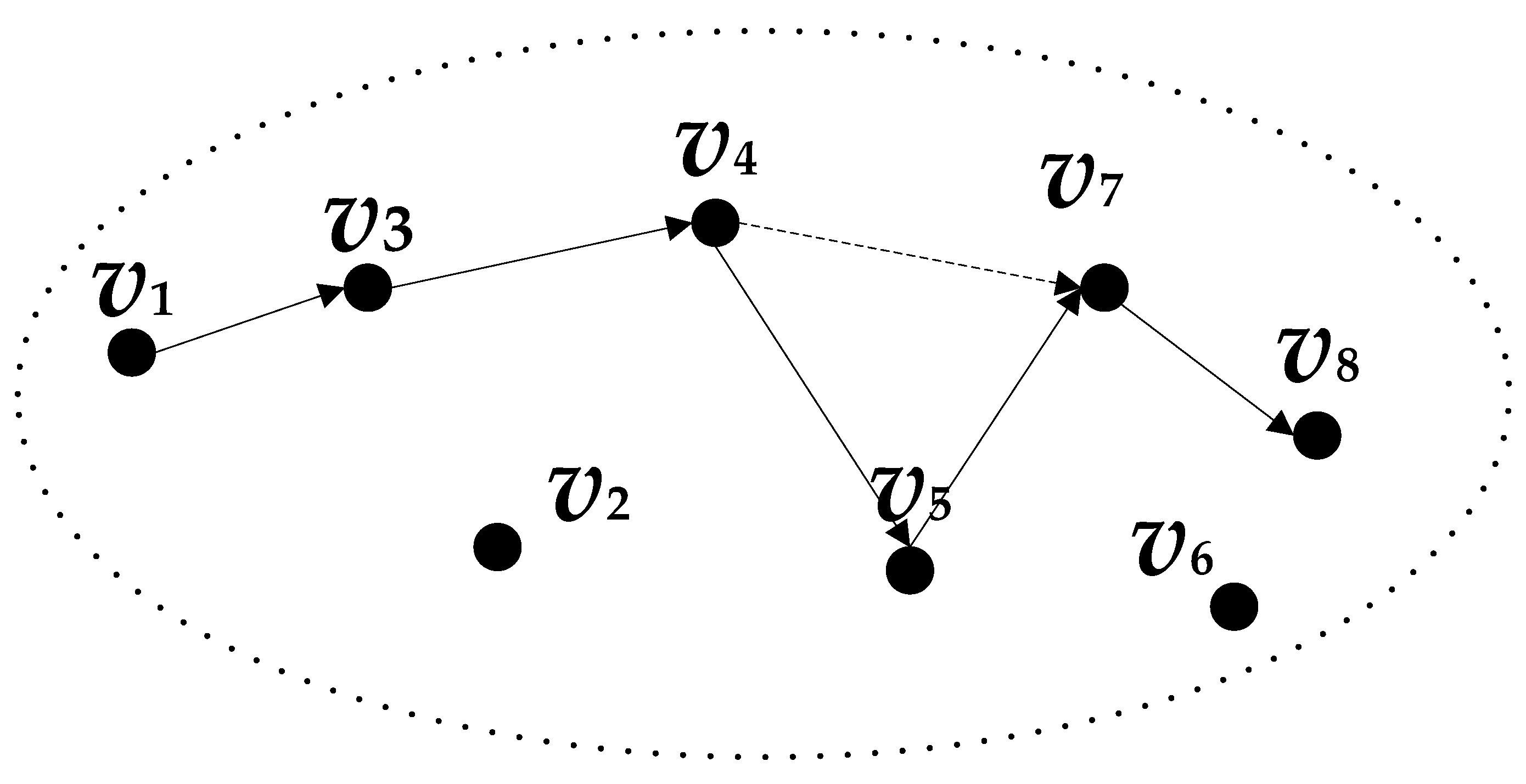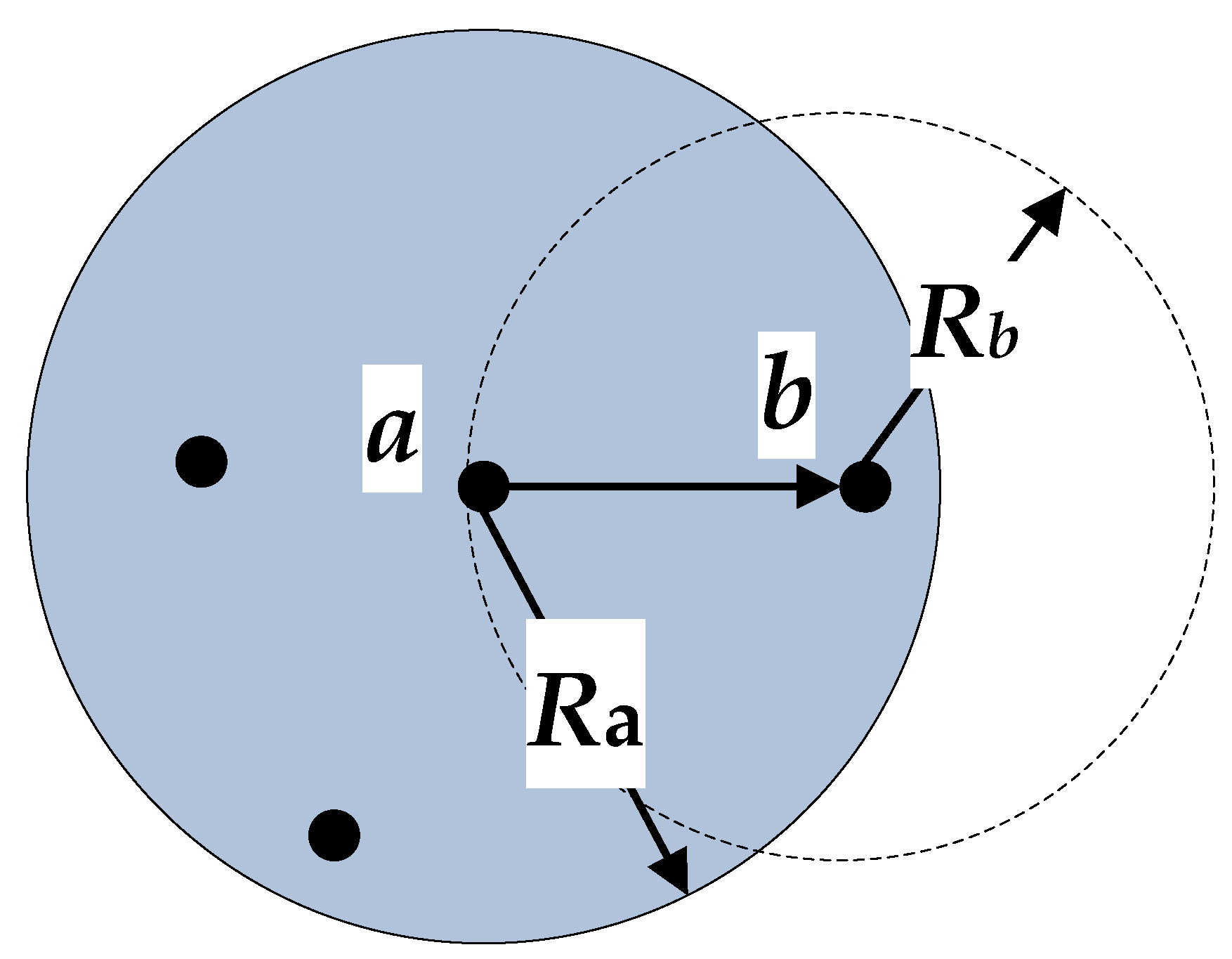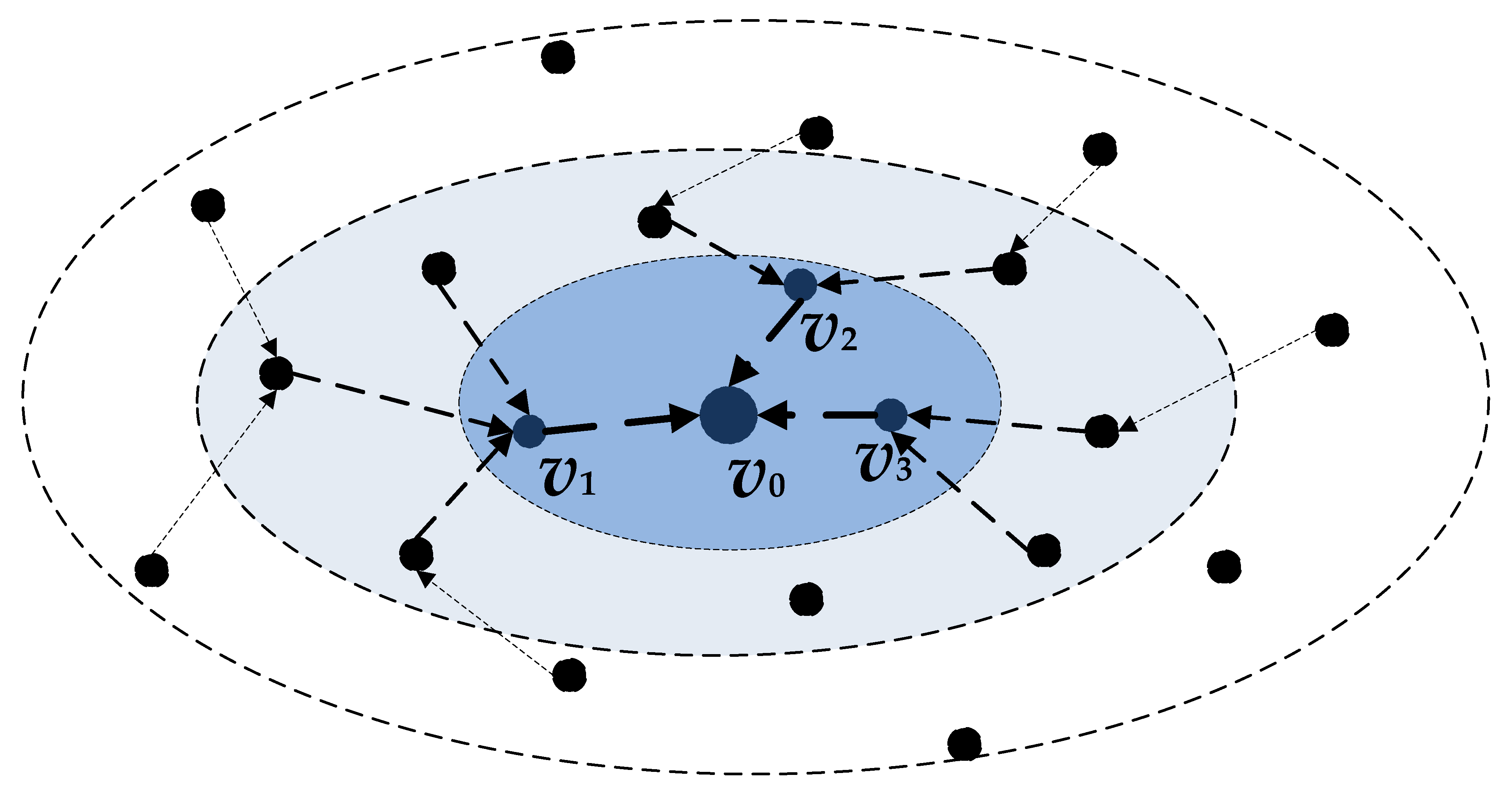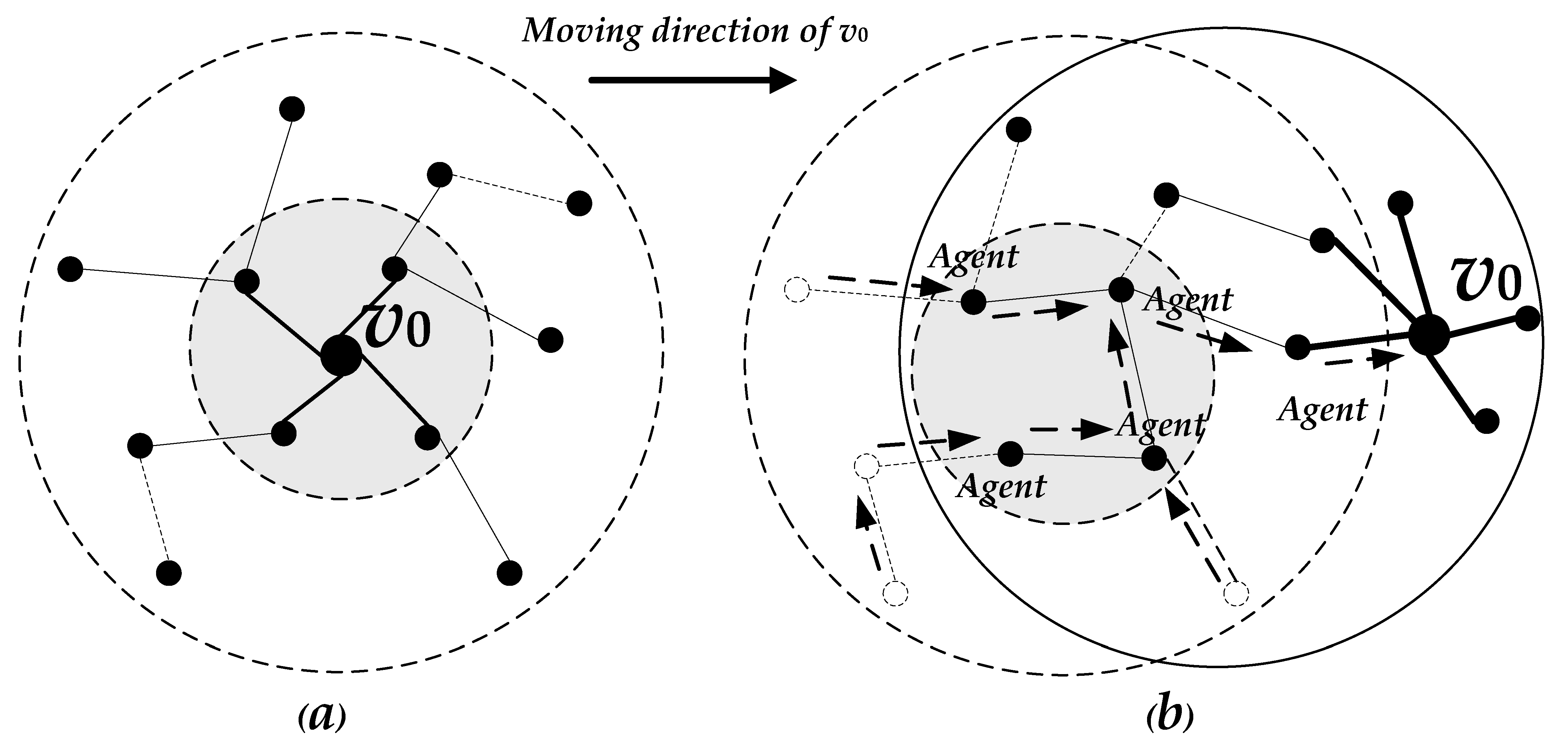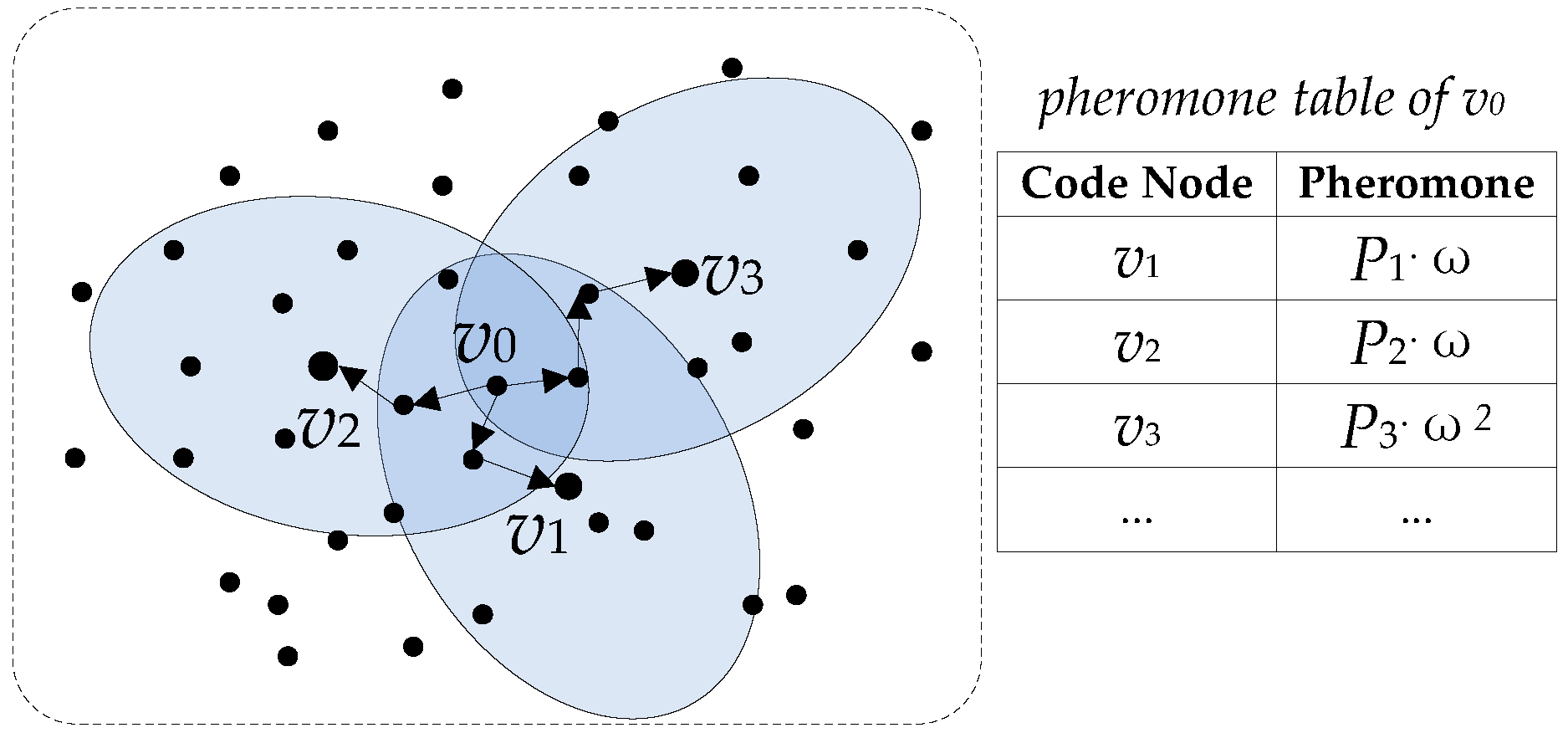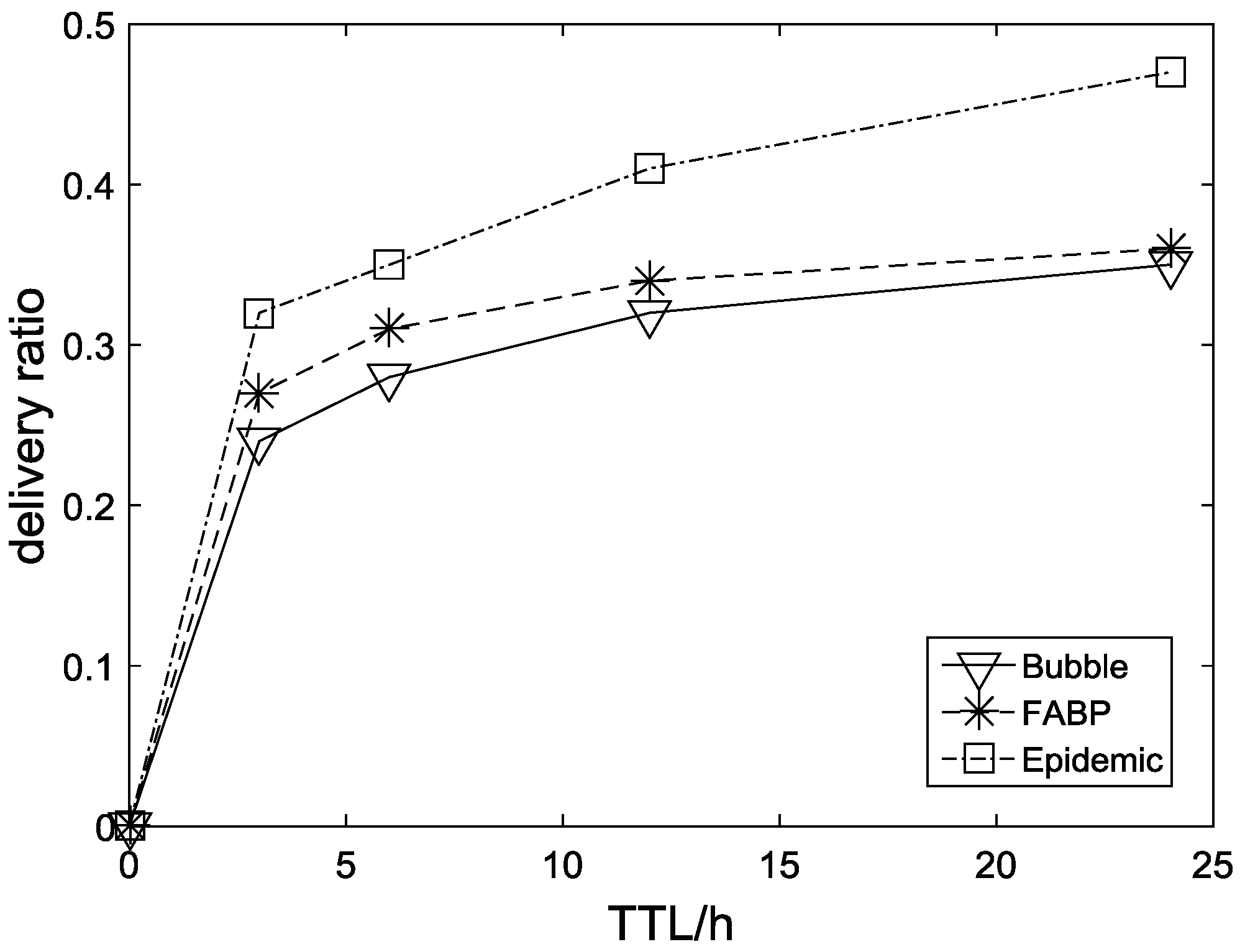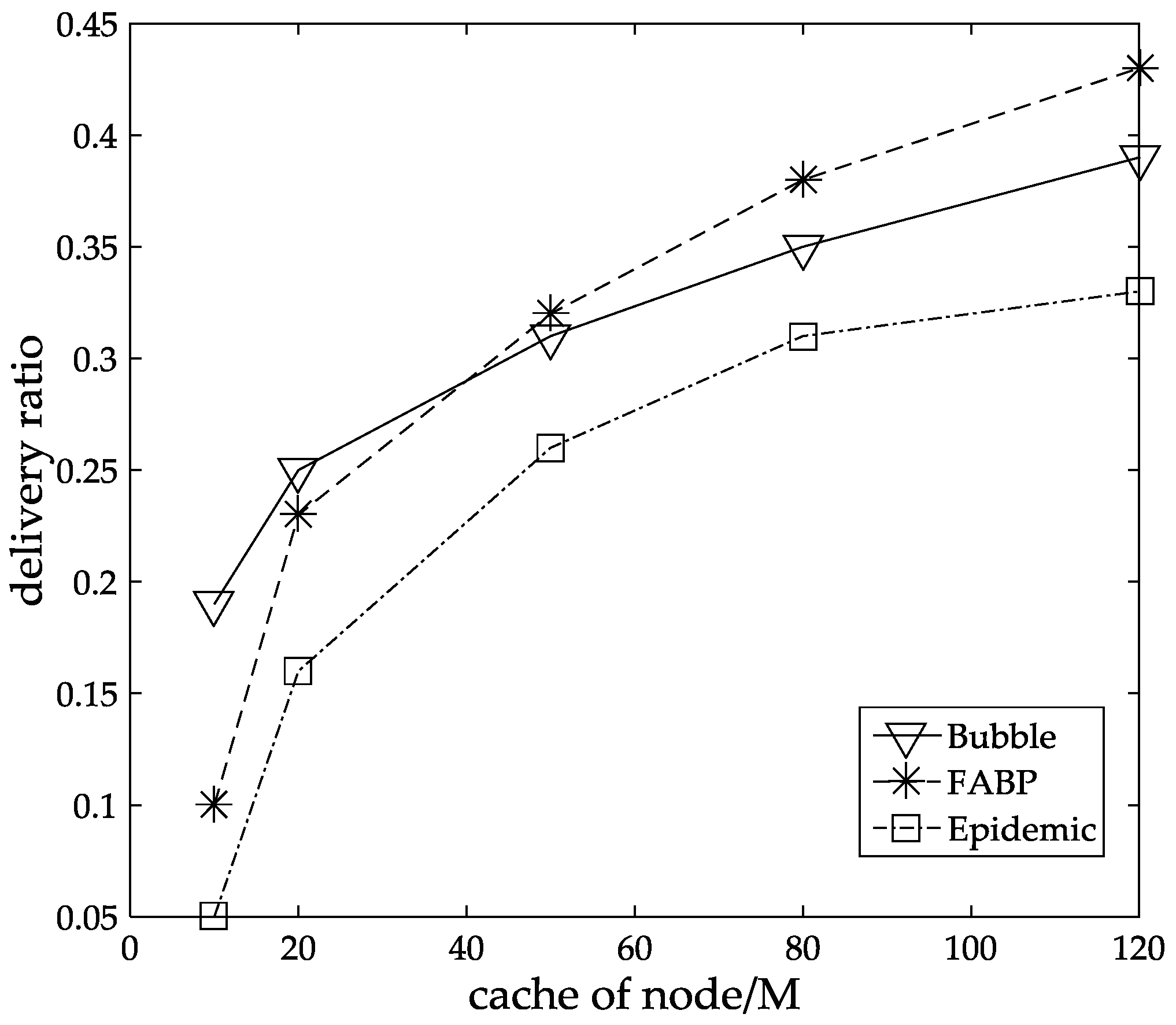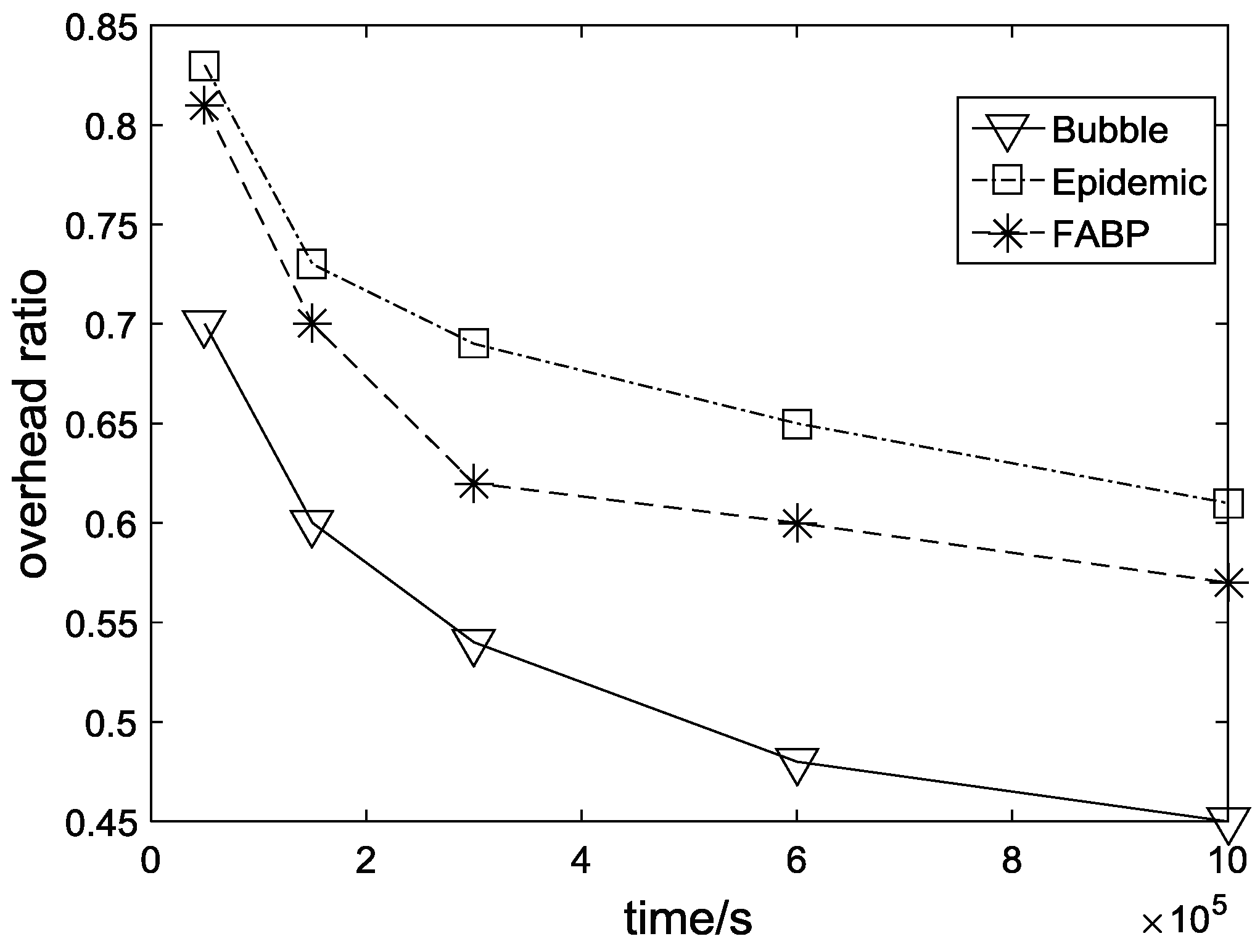1. Introduction
The development of wireless communication technology has resulted in a portable intelligent terminal that consists of a special delay-tolerant networking (DTN) [
1] that can be carried by people to be used in their daily lives. Although such a terminal may not comprise an end-to-end connected path among nodes that are required to exchange information in a network that lacks certain infrastructure, it can still achieve information exchanges from the source node to the destination node. If one node enters the communication range of others, then they can exchange information until they move out of the communication range. However, long delay, low signal-to-noise ratio, and asymmetric information transmission exist, along with information exchange among nodes in the network, which, in turn, lead to topology variability. Consequently, existing data transfer protocols for traditional networks may not achieve good performance when applied to new network structures. Thus, providing a novel algorithm that can obtain efficient packet forwarding in a variable network topology becomes a key interest domain.
For networks that consist of intelligent terminals, the mobile nodes are communication terminals that are frequently carried by users. Therefore, the characteristic of this type of network will be similar to that of social networks. A short-term, relatively stable communication structure can be formed among users in the same place, such as passengers on the same train and employees in the same office. This short-term, relatively stable communication structure can be represented by a transient community structure [
2]. Eyuphan et al. [
3] consider that it should have a high contact frequency, a longer contact time, and relatively fixed interactive activities between friends and design a mixed metric that contains contact frequency, average length of contact, and regularity of contact, to detect the quality of friendships between nodes. However, this relationship does not apply to nodes whose distance is over two hops; hence, it cannot represent the betweenness centrality of a node. Pei Yan et al. [
4] constructed frequent movement patterns of nodes by analyzing the hotspots that nodes visited, and computed the centrality of nodes based on the movement patterns. Then, they utilized the inverse symmetrized entropy of the personal hotspots between two nodes to compute the similarity between them. Even so, this may be of low efficiency when the hotspots change.
Ref [
5] compared the number of same neighbors among nodes to determine whether the nodes belong to the same community. In this manner, nodes can be classified into different communities that contain nodes with a tight connection. However, nodes in such a community cannot obtain the relative location of others, and the current node cannot indicate the direction when forwarding packets to the destination node. Therefore, the path for packet forwarding may not be the best. The packet-forwarding path in a community without a core node is illustrated in
Figure 1.
In
Figure 1, we suppose that ν
1 is required to forward the packet to ν
8 and packet forwarding to node ν
4 occurs at present. When ν
4 is forwarding the packet to the destination node, it must select a relay node from ν
5 and ν
7, and if ν
5 was chosen, it would increase the total forwarding hops, and the cost of packet forwarding will increase. To address this problem, we study and analyze the role of pheromones in the process of moth mating and attempt to use it in the packet-forwarding process in DTN. First, we can compute the communication capability between the neighbor and core nodes according to the analysis of the connections and disconnections between them, which can be the analog pheromone of the core node. Second, we apply the six degrees of separation theory [
6] to spread the analog pheromone to nearby nodes within a four-hop distance. The community can then be constructed based on the analog pheromone of the core node. We propose a simple and efficient packet forwarding algorithm (Packet Forwarding Algorithm Based on Pheromone, FABP) based on this special community structure.
In the proposed algorithm (FABP), the pheromone of the core node is calculated periodically and then spread to the surrounding neighboring nodes via the attenuation model. Every node that receives the pheromone will update itself and spread it via the attenuation model. If a node cannot receive the pheromone within a certain period, then it will decrease the pheromone of the destination node until it reaches zero. If the pheromone of the node becomes zero, then the current node detaches from the community. Taking advantage of the pheromone, if a packet is forwarded to nodes that hold the pheromone of the destination node, and then the packet will be delivered to the destination node along the direction where the pheromone is stronger. A high delivery rate and a low forwarding delay can then be obtained.
The remainder of this paper is organized as follows:
Section 2 discusses related works;
Section 3 describes the proposed network model and its analysis;
Section 4 provides the designed packet-forwarding algorithm based on community structure;
Section 5 presents the experimental results and discussion; and, finally,
Section 6 concludes this study.
2. Related Works
The traditional packet-forwarding algorithm cannot perform efficiently because of the intermittent link among nodes and because the network topology changes with a high frequency. Thus, the strategy of “store-carry-forward” is proposed to overcome the problem caused by the frequent interruptions of links among nodes in DTN. The selection of a relay node will significantly affect the forwarding delay and packet delivery success rate in the process of “store-carry-forward”. Hence, such selection has recently become a crucial research area. A community can be classified into two types according to whether social features are to be used in the process of selecting relay nodes. The first type uses social features in the packet-forwarding process [
2,
5,
7,
8,
9,
10,
11], whereas the second type does not consider these features [
12,
13,
14,
15]. Vahdat et al. [
13] proposed the epidemic algorithm for DTN, which was a typical algorithm belonging to the second type. When one node meets another node, they should exchange messages that are different between them. Consequently, all non-isolated nodes will receive messages after a certain number of information exchanges. Although the high packet delivery success rate is the most notable feature of the epidemic algorithm, high resource consumption will occur during the packet-forwarding process. Consequently, this algorithm cannot achieve good performance in a real network that cannot provide sufficient resources.
Jianzhi et al. [
14] divided the packet-forwarding process into two stages, namely, spray and wait. During the spray stage, the source node spreads the message to its neighbors. The message spread by the source will then be carried until it meets the destination node during the wait stage. Taking advantage of the fixed quota for copying, this process can optimize the consumption of node resources in the epidemic algorithm. Compared with the previous forwarding algorithm, the relations among node carriers are utilized in the second type of forwarding algorithm. The nodes are classified into different communities based on several special characteristics of node carriers. The relationship among the inner nodes of the community is tighter than that among the outer nodes. In [
7], Hui et al. proposed the bubble algorithm, which would select the relay node with high betweenness centrality or that belonged to the community of the destination node during the packet-forwarding process. The global betweenness centrality of a node controls the selection of the relay node until the packet enters the destination community. The local betweenness centrality of a node will then replace the global one to influence the selection of the relay node in the destination community. Nevertheless, if every node holds low global betweenness centrality, then bubble may not achieve satisfactory performance. A routing protocol based on clustering structure is proposed [
10], which classifies the nodes with similar mobility traces into a cluster of recent social circle. The entire process of the routing protocol is divided into three stages, namely, spraying, forwarding among clusters, and “flooding” in the inner cluster. Given the lack of an appropriate node removal mechanism in the cluster, the scalar of the number of clusters may become significantly large, and the routing protocol will evolve into “flooding” over time.
Yongfeng et al. [
9] defined communities
C1 and
C2 that were maintained by the same node within different time windows. According to the Jaccard index, the similarity between
C1 and
C2 can be represented as:
The similarity between C1 and C2 is identified by computing the ratio between their common and total numbers. In this manner, the similarity of the community that contains the node with ID = 29 for five consecutive days can be computed, which is a discrete value that is distributed from 0.4 to 0.6. Accordingly, 70% of the community members are relatively stable. This finding is important for our research. We can utilize the relatively stable structure of the network to improve the efficiency of packet forwarding.
By studying the recently published typical DTN routing algorithms [
2,
5,
7,
10,
11], we can know that the betweenness centrality of a node is most important in the process of selecting a relay node; it represents the capability of the current node to forward a packet to the destination. Freeman et al. [
16] proposed a technique to compute the betweenness centrality of a node by collecting all node information in DTN. However, given that the node location is easy to change in DTN, one node cannot easily obtain global information. This algorithm may consequently cause a considerable deviation in the betweenness centrality of a node. If every packet forwarded by the nodes has high betweenness centrality, then excessive consumption of the resources of these nodes may occur.
To overcome the problem of requiring global information in computing betweenness centrality, we utilize the pheromone held by a candidate relay node to represent the betweenness centrality of a current node. Considering that the pheromone can be periodically flood from the destination node, the pheromone can be easily generated without global information. The excessive consumption of the resources of a relay node can, thus, be avoided because different destination nodes spread various pheromones.
Acknowledgments
This work is supported by the National Natural Science Foundation of China under Grant Nos. 61572261 and 61300239, the Natural Science Foundation of Jiangsu Province under Grant No. BK20150868, the China Postdoctoral Science Foundation funded project under Grant No. 2014M551635, the Jiangsu Planned Projects for Postdoctoral Research Funds under Grant No.1302085B, the Open Fund for the Key Laboratory for Traffic and Transportation Security of Jiangsu Province under Grant No. TTS201502, and the Major Scientific Research Project of Higher Learning Institution of Henan Province under Grant No. 15A520051.
Author Contributions
Tiezhu Li mainly designed the research scheme and wrote the paper. Lijuan Sun supervised the work. Chong Han performed the research and wrote the paper. Jian Guo obtained and analyzed the data. All authors have read and approved the final manuscript.
Conflicts of Interest
The authors declare no conflict of interest.
References
- Hui, P.; Chaintreau, A.; Scott, J.; Gass, R.; Crowcroft, J.; Diot, C. Pocket switched networks and human mobility in conference environments. In Proceedings of the 2005 ACM SIG-COMM Workshop on Delay-tolerant Networking, Philadelphia, PA, USA, 26–26 August 2005; pp. 244–251.
- Gao, W.; Cao, G.; La Porta, T.; Han, J. On Exploiting Transient Social Contact Patterns for Data Forwarding in Delay-Tolerant Networks. IEEE Trans. Mob. Comput. 2013, 12, 151–164. [Google Scholar] [CrossRef]
- Bulut, E.; Szymanski, B. Exploiting friendship relations for efficient routing in mobile social networks. IEEE Trans. Parallel Distrib. Syst. 2012, 23, 2254–2265. [Google Scholar] [CrossRef]
- Yuan, P.Y.; Ma, H.D. Differentiation forwarding with hotspot. Interat. J. Ad Hoc Ubiquitous Comput. 2014, 15, 227–238. [Google Scholar] [CrossRef]
- Hui, P.; Yoneki, E.; Chan, S.; Crowcroft, J. Distributed Community Detection in Delay Tolerant Networks. In Proceedings of the 2nd ACM/IEEE International Workshop on Mobility in the Evolving Internet Architecture, Kyoto, Japan, 27–30 August 2007.
- Lawrence, E.; Latha, R. Analysis of six degrees of separation in Facebook using Ant colony optimization. In Proceedings of 2015 International Conference on Circuit, Power and Computing Technologies (ICCPCT), Nagercoil, India, 19–20 March 2015; pp. 1–5.
- Hui, P.; Crowcroft, J.; Yoneki, E. BUBBLE Rap: Social-Based Forwarding in Delay Tolerant Networks. IEEE Trans. Mob. Comput. 2010, 10, 1576–1589. [Google Scholar] [CrossRef]
- Yuan, P.Y.; Ma, H.D.; Duan, P.R. Impact of strangers on opportunistic routing performance. J. Comput. Sci. Tech. 2013, 28, 574–582. [Google Scholar] [CrossRef]
- Huang, Y.-F.; Dong, Y.-Q.; Zhang, S.-F.; Wu, G.-X. Message forwarding based on periodically evolving social characteristics in opportunistic mobile networks. J. Commun. 2015, 36, 151–162. [Google Scholar]
- Zhao, D.; Ma, H.D.; Tang, S.J.; Li, X.Y. COUPON: A cooperative framework for building sensing maps in mobile opportunistic networks. IEEE Trans. Parallel Distrib. Syst. 2015, 26, 392–402. [Google Scholar] [CrossRef]
- Yang, S.; Wu, J. Adaptive Backbone-Based Routing in Delay Tolerant Networks. In Proceedings of the 2013 IEEE 10th International Conference on Mobile Ad-Hoc and Sensor Systems, Hangzhou, China, 14–16 October 2013; pp. 356–364.
- Wu, J.; Xiao, M.; Huang, L. Homing Spread: Community Home-Based Multi-Copy Routing in Mobile Social Networks. In Proceedings of the IEEE INFOCOM 2013, Turin, Italy, 14–19 April 2013; pp. 2319–2327.
- Vahdat, A.; Becker, D. Epidemic routing for partially connected ad hoc networks. Master’s Thesis, Duke University, Durham, NC, USA, 2010. [Google Scholar]
- Sun, J.Z.; Han, Z.M.; Chen, D.; Li, Y.H. Wait and spray: Improved routing algorithm of opportunistic network. Comput. Eng. Appl. 2011, 47, 91–93. [Google Scholar]
- Khanna, B.; Redi, J.; Basu, P.; Ramanathan, R. Disrupted Adaptive Routing: Gossip-Based Routing in Delay-Tolerant Networks. In Proceedings of the 2013 IEEE Military Communications Conference, San Diego, MA, USA, 18–20 November 2013; pp. 1099–1104.
- Girvan, M.; Newman, M.E.J. Community structure in social and biological networks. Proc. Natl. Acad. Sci. USA 2002, 99, 7821–7826. [Google Scholar] [CrossRef] [PubMed]
- Keranen, A.; Ott, J.; Karkkainen, T. The ONE simulator for DTN protocol evaluation. In Proceedings of the 2nd International Conference on Simulation Tools and Techniques, Rome, Italy, 2–6 March 2009.
- Mit/reality dataset. Available online: http://crawdad.org/mit/reality/20050701/ (accessed on 20 May 2015).
© 2016 by the authors; licensee MDPI, Basel, Switzerland. This article is an open access article distributed under the terms and conditions of the Creative Commons Attribution (CC-BY) license (http://creativecommons.org/licenses/by/4.0/).
